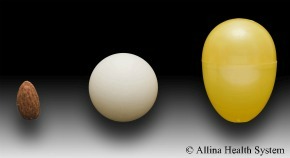
How to tell if your baby is getting enough milk
Newborns have small stomachs that are not much bigger than an almond. Babies need to feed every few hours. It is normal for new babies to feed eight to 12 times every 24 hours.

Your baby's stomach grows from the size of an almond (day one) to a ping pong ball (day three) to a medium chicken egg (day seven). The amount of breastmilk your baby can hold will increase from one teaspoon to up to two ounces during that time.
Newborns usually take between one-half to one ounce per feeding the first few days. Although it is difficult to measure the exact amount of milk, there are ways to reassure yourself and others that your baby is getting enough milk.
In general, you can tell if your baby is getting enough milk if:
- they feed eight to 12 times in 24 hours
- they have bursts of sucking and swallowing
- they appear satisfied after feeding
- there are enough wet and soiled diapers based on their age
- they regain their birth weight in 10 to 14 days
Wet diapers
After the first week your baby should have at least six wet diapers a day. If it is difficult for you to tell if the diaper is wet, you can put a sheet of facial tissue in the diaper. You can easily tell if the tissue is wet. Stop doing this when you are reassured about your baby's urine output.
Call your baby's health care provider or your lactation resource if you don't think your baby is getting enough milk.
Soiled diapers
Most babies have their first bowel movement within a few hours after birth. You can expect your baby will have at least three soiled diapers a day by the third or fourth day.
Stools from breastfed babies change in color and consistency during the first week:
- Days 1 to 2: your baby passes meconium. Meconium is your baby's first stool. It will be black and tarry. This is normal.
- Days 2 to 4: the stools will become less sticky, lighter in color and more liquid.
- Days 3 to 5: the stools will be green-yellow to mustard yellow, seedy and liquid.
- Days 5 and on: the stools will be mustard-yellow, seedy and liquid.
Colostrum and mature breastmilk will cause loose stools that pass easily. This helps prevent constipation.
It is normal for breastfed babies to have runny, seedy and yellowish stools.
Weight gain
Your baby should regain their birth weight in 10 to 14 days. After that, most babies gain from four to eight ounces a week.
How your baby feeds
Your baby should wake every two to three hours and actively nurse. The time periods may be one to three hours during the day and three to four hours at night. Some babies cluster feed just before a longer sleep between feedings.



